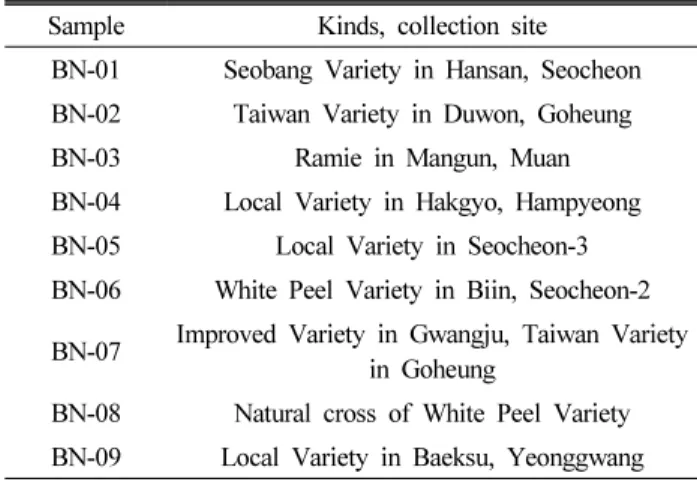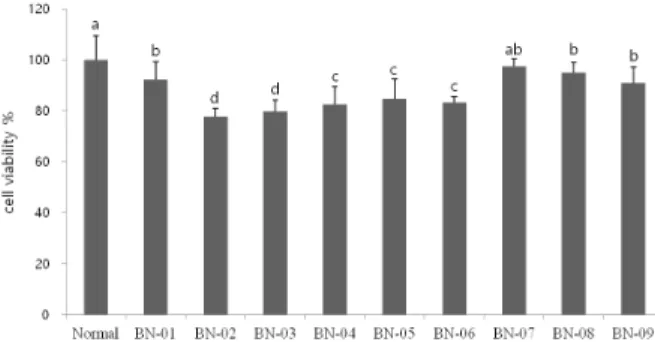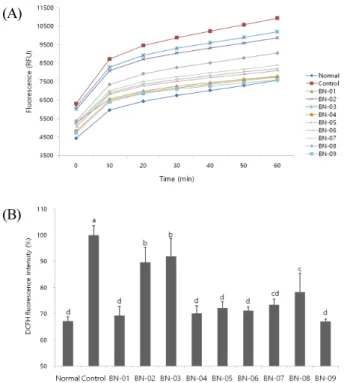Protective Effects of Ramie ( Boehmeria nivea) against Oxidative Stress in C6 Glial Cells
Xiaoning Wang 1 , Sunghun Cho 2 , Ho Bang Kim 3 , Yong-Su Jung 4 , Eun Ju Cho 1 and Sanghyun Lee 2 *
1
Department of Food Science and Nutrition, Pusan National University, Busan 46241, Korea
2
Department of Integrative Plant Science, Chung-Ang University, Anseong 17546, Korea
3
Life Sciences Research Institute, Biomedic Co. Ltd., Bucheon 14548, Korea
4
Yeong-Gwang Agricultural Technology Center, Yeonggwang 57031, Korea
Abstract - β amyloid protein (Aβ) plays a critical role in the pathogenesis of Alzheimer's disease (AD) and possibly in Aβ -induced mitochondrial dysfunction and oxidative stress. A β can directly cause reactive oxygen species (ROS) production.
Overproduction of ROS is considered to be involved in the pathogenesis of neurodegeneration of AD. Here, we investigated 9 kinds of ramie ( Boehmeria nivea, (L.) Gaud., BN; hereafter denoted as BN) for their protective action against oxidative stress in a cellular system using C6 glial cells. We observed loss of cell viability and high levels of ROS generation after treatment with hydrogen peroxide (H
2O
2) and A β
25-35. However, treatments with BN extracts led to an increase in cell viability and decrease in ROS production induced by H
2O
2and Aβ
25-35. In particular, the extracts of BN-01 (seobang variety from Seocheon) and BN-09 (local variety from Yeonggwang) showed excellent anti-oxidative properties. This indicates that BN extracts could prevent neurodegeneration by reducing oxidative stress in cells.
Key words - Boehmeria nivea, Alzheimer’s disease, Reactive oxygen species, C6 glial cell
*Corresponding author. E-mail : slee@cau.ac.kr Tel. +82-31-670-4688
ⓒ 2015 by The Plant Resources Society of Korea
Introduction
Oxidative stress is a potential threat to most aerobic organisms and plays a crucial role in biocontrol systems. It leads to neuro-degeneration, also it has been closely implicated to neurodegenerative disorders (Di Carlo et al., 2012; Han and Wang, 2010; Lee and Cho, 2007). Oxidative stress is one of the earliest events in Alzheimer’s disease (AD) (Nunomura et al., 2001) and β amyloid protein (Aβ) is known to contribute to the oxidative damage leading to neuronal impairment (Yatin et al., 1999). In addition, oxidative stress is associated with enhanced levels of reactive oxygen species (ROS) and reactive nitrogen species (RNS) (Castoria et al., 2003;
Macarisin et al., 2010). At low levels, ROS act as signaling molecules to regulate cellular functions. However, at high levels, they cause oxidative stress (Madeo et al., 1999; Tatone et al., 2010). In particular, the ROS containing O
2―, H
2O
2,
1O
2, HO
2―, ․ OH, ROOH, ROO ․, and RO ․ radicals are highly
reactive and toxic. They cause damage to proteins, lipids, carbohydrates, and DNA which ultimately results in cell death (Gill and Tuteja, 2010). Neurons are most susceptible to direct oxidative injury by ROS and RNS (Juvenet, 1889;
Butterfield and Lauderback, 2002). Glial cells are very important for normal brain function and oxidative damage can cause rapid changes in almost all cells including glial cell (Araujo and Cotman, 1992; Zhao et al., 2013). Therefore, one of the most promising therapeutic strategies for the treatment of neurodegenerative diseases, including AD, is the reduction of oxidative damage in cells.
Ramie ( Boehmeria nivea (L.) Gaud., BN; hereafter referred to as BN) is a member of the nettle family (Urticaceae) and is mainly grown in temperate and tropical areas including China, Korea, Philippines, and India (Angelini et al., 2000;
Wang et al., 2006). Popularly known as “China grass”, it is a perennial herbaceous plant and has been used as a textile fiber for centuries because of its excellent fiber quality (Wood and Angus, 1974; Liu et al., 2001). It is rich in nutrients such as vitamins, minerals, and various bioactive substances (Gupta and Wagle, 1988). Phytochemicals are bioactive substances
Original Research Article
Table 1. BN kinds and their collection sites
Sample Kinds, collection site
BN-01 Seobang Variety in Hansan, Seocheon BN-02 Taiwan Variety in Duwon, Goheung
BN-03 Ramie in Mangun, Muan
BN-04 Local Variety in Hakgyo, Hampyeong BN-05 Local Variety in Seocheon-3 BN-06 White Peel Variety in Biin, Seocheon-2 BN-07 Improved Variety in Gwangju, Taiwan Variety
in Goheung
BN-08 Natural cross of White Peel Variety BN-09 Local Variety in Baeksu, Yeonggwang of plants that have been associated with the protection of
human health against chronic degenerative diseases (Fuku- moto and Mazza, 2000). The major compounds of chemical constituents are chlorogenic acid, rutin, luteolin-7-glucoside, naringin, hesperidin, and tangeretin (Park et al., 2010). It is known to contain behenic acid, ursolic acid, β-sitosterol, cholesterol, kiwiionoside, uracil, quercetin, α-amyrin, nona- cosanol, emodin, emodin-8- O-β-glucoside, physcion, polydatin, catechin, epicatechin, and epicatechin gallate (Nho et al., 2010; Shao et al., 2010). It has been used in foods such as cookies (Yoon and Jang, 2006) and Jeolpyun (traditional Korean rice cakes) (Tian et al., 2011). The edible parts of this plant - the leaves and roots - have been reported to have anti-inflammatory and anti-fungal effects (Xu et al., 2011;
Sung et al., 2013), in addition to anti-hepatitis B and anti-diabetic effects (Huang et al., 2006; Kim et al., 2013). However, whether ramie has a neuroprotective effect has not been determined. In our previous study, we screened the biological activities of 90 kinds of Korean ramie (Lee et al., 2014).
Among them, 9 kinds cultivated in Seocheon, Goheung, Muan, Hampyeong, and Yeonggwang showed excellent biological anti-oxidative, anti-bacterial, anti-inflammatory, and anti-cancer properties (Lee et al., 2014).
Therefore, in this study we evaluated the extracts from these 9 kinds for their potential in treating AD; for this, we measured their ability to reduce H
2O
2and Aβ
25-35-induced oxidative stress in C6 glial cells.
Materials and Methods
Plant materials and preparation of extracts
Nine kinds of ramie were collected by the staff at the Yeong-Gwang Agricultural Technology Center, Korea (Table 1). Ten grams of dried BN were extracted with MeOH (200
㎖ × 3) under reflux conditions and the solvent was evaporated in vacuo. Each individual MeOH extract (0.1 ㎎) was dissolved in dimethyl sulfoxide (DMSO) (5 ㎕).
Instruments and reagents
MeOH was purchased from Sam Chun Pure Chemical Co.
(Pyeongtaek, Korea). C6 glial cells were obtained from the Korea Cell Line Bank (KCLB, Korea). Dulbecco’s Modified
Eagle Medium (DMEM), fetal bovine serum (FBS), trypsin EDTA, and penicillin-streptomycin (100 unit/ ㎖) were obtained from Welgene (Daegu, Korea). Hydrogen peroxide (H
2O
2) was purchased from Junsei Chemical Co. (Tokyo, Japan). The 3-(4,5-dimethylthiazol-2-yl)-2,5-diphenyl tetrazolium bromide (MTT) was purchased from Bio Basic Canada Inc. (New York, USA). DMSO and A β
25-35were obtained from Sigma Chemical Co. (Louisiana, USA).
Cell culture
C6 glial cells were cultured in DMEM medium (pH 7.2) containing 100 U/ ㎖ of penicillin streptomycin and 10% FBS at 37℃ in a 5% CO
2incubator. Cells were sub-cultured 5 days with 0.05% trypsin-EDTA in phosphate buffered saline (PBS).
Cell viability assay
Once the cells reached 80-90% confluence, they were
plated into 96-well plates at 5 × 10
4cells/㎖ and cells were
incubated with medium for 2 h before treatment with H
2O
2/A
β
25-35and BN extracts. BN extracts (25 ㎍/㎖) and H
2O
2(250
µM) or A β
25-35(25 µM) were added, and the plates were
incubated for 24 hr. Thereafter, 100 µL of MTT (5 ㎎/㎖)
solution was added to each well. After the incubation for 4 h
at 37℃, the medium was removed from the plate. The resultant
formazan crystals in the C6 glial cells were solubilized by
adding 100 ㎕ of DMSO. The absorbance of each well was
read at 540 ㎚ using a microplate reader (Molecular Devices,
Sunnyvale, USA) (Mosmann, 1983).
Fig. 1. Cytotoxicity of BN extracts at on viability of C6 glial cells.
Values are represented as the mean ± SD.
a~d
Means with different superscripts within each column are significantly different ( P < 0.05) by Duncan’s multiple range test.
Fig. 2. Effect of BN extracts on viability of C6 glial cells treated with H
2O
2.
Values are represented as the mean ± SD.
a~g
Means with different superscripts within each column are significantly different ( P < 0.05) by Duncan’s multiple range test.
Normal group is no-treated with H
2O
2; Control group is treated with H
2O
2.
ROS measurement
Cells were plated into black 96-well plates at 5 × 10
4cells/㎖
and cells were incubated with medium for 2 h before treatment with H
2O
2/A β
25-35and BN extracts. BN extracts (25 ㎍/㎖) were added, and the plates were incubated for 24 hr. Cells were washed twice with PBS, and incubated with dichloro- dihydro-fluorescein diacetate (DCFH-DA) (Sigma Chemical Co., Louisiana, USA) 20 µM for 30 min. Thereafter, H
2O
2(250 µM) or A β
25-35(25 µM) was treated for 24 h, and the wells were read by FLUOstar OPTIMA (BMG Labtech., Ortenberg, Germany) at an excitation wavelength of 480 ㎚ and an emission wavelength of 535 ㎚ (Byun et al., 2009).
Statistical analysis
Significance was verified by performing Duncan’s multiple range tests using SAS software (version 6.0, SAS Institute, Cary, USA) to analyze the differences between the control and sample treated groups. Differences between groups were considered significant when the P-value was less than 0.05.
The experimental results were expressed as means ± standard deviation (SD) (n = 6).
Results and Discussion
Protective effects of BN extracts against H
2O
2-induced oxidative stress and ROS levels in C6 glial cells
ROS impairs the physiological functions of C6 glial cells and causes cell death. Free radicals, such as O
2―, ․ OH, and
․
1O
2, as well as non-radical species, such as H
2O
2, cause cell damage by increasing oxidative stress (Chen and Gibson, 2008). H
2O
2is known to be a strong inducer of ROS, and if present at high levels promotes cell death (Woo et al., 2003;
Miller et al., 2010). The cytotoxicity test using MTT assays is shown in Fig. 1. The treatment of BN extracts showed 77.8%
to 97.5% of cell viability. Most of the BN extracts showed little or no cytotoxic activity in C6 glial cells up to 25 ㎍/㎖, therefore we used the concentration of 25 ㎍/㎖. The protective effect of the BN extracts against H
2O
2-induced oxidative stress in C6 glial cells is shown in Fig. 2. Cell viability was significantly lower (58.2%) in H
2O
2-treated cells than in untreated cells. Cell viability improved when the 9 kinds of BN extracts were added at concentration of 25 µg/ml. BN-04,
BN-05 and BN-08 have a little cytotoxic activity in C6 glial cells, so it showed lower cell viability than control group. On the other hand, the BN-01 (64.4%), BN-02 (64.1%), BN-03 (63.5%), BN-06 (64.5%), BN-07 (78.6%), and BN-09 (70.1%) shown higher than cell viability of control group, which indicate the protective activity against oxidative stress induced by H
2O
2. The production of ROS was monitored using DCFH-DA, a standard compound used to detect and quantify intracellularly produced H
2O
2(Myhre, 2003). The fluorescence was pro- portional to the amount of ROS produced by the cells (Fig. 3).
ROS generation in H
2O
2-treated cells was markedly higher,
but in cells treated with the 9 kinds of BN extracts, there was
(A)
(B)
Fig. 3. Effect of BN extracts on level of reactive oxygen species in C6 glial cell treated with H
2O
2(A: Time course of change in intensity of fluorescence with the BN extracts, B:
The production of ROS after treatment with BN extracts).
Values are represented as the mean ± SD.
a~d
Means with different superscripts within each column are significantly different ( P < 0.05) by Duncan’s multiple range test.
Normal group is no-treated with H
2O
2; Control group is treated with H
2O
2.
Fig. 4. Effect of BN extracts on viability of C6 glial cells treated with A β
25-35.
Values are represented as the mean ± SD.
a~e
Means with different superscripts within each column are significantly different ( P < 0.05) by Duncan’s multiple range test.
Normal group is no-treated with A β
25-35; Control group is treated with A β
25-35.
a decrease in DCFH oxidation. In particular, BN-01 (69.3%), BN-04 (70.2%), and BN-09 (67.1%) showed strong protective effect against ROS levels. These results show that BN extracts can protect against H
2O
2-induced oxidative stress and decrease ROS productions in C6 glial cells.
Protective effects of BN extracts against Aβ
25-35-induced oxidative stress and ROS levels in C6 glial cells
A β, a byproduct formed during the processing of amyloid precursor protein, is a major constituent of senile plaques, suggesting that its deposition play a role in the pathogenesis of AD (Pike et al., 1995; Xio et al., 2000). Elevation of oxidative stress and activation of the apoptotic pathway play key roles in mediating A β-induced toxicity and neural cell death (Behl ll., 1994; Santos et al., 2005), which is observed in the brains of patients with AD (Markesbery, 1997; Butterfield
et al., 2001). In the present study, we used Aβ
25-35that was dissolved in sterile distilled water and precipitated by incubation at 37 ℃ for 3 days. The protective effect of the BN extracts against Aβ
25-35-induced oxidative stress in C6 glial cells is shown in Fig. 4. Aβ
25-35-treated cells (25 µM) showed lower viability (56.6%) than untreated cells. BN extracts were added at a concentration of 25 ㎍/㎖. Among the 9 kinds of BN extracts, the BN-01, BN-02, BN-04, BN-05, BN-06, BN-08, and BN-09 extracts improved cell viability. In particular, BN-01 (62.3%), BN-05 (62.5%), BN-08 (64.0%), and BN-09 (61.2%) showed significant high cell viability compared to control group. It suggests that BN-01, BN-05, BN-08 and BN-09 would play the protective role against Aβ
25-35-induced oxidative stress.
ROS generation in Aβ
25-35-treated cells was higher, but cells treated with the 9 kinds of BN extracts showed a decrease in DCFH oxidation. As shown in Fig. 5, 9 kinds of BN extracts were able to prevent the increase of ROS production induced by Aβ
25-35compared to non-treated control conditions.
Therefore, BN extracts protect against A β
25-35-induced
oxidative stress and decrease ROS production in C6 glial
cells. On the other hand, the protective activity from oxidative
stress and ROS generation did not affect cell viability. It
indicated that the other factors are related to cell survival or
death. BN-04, BN-05 and BN-08 have also led to the decline
of ROS generation. Combining with the cell viability and
(A)
(B)
Fig. 5. Effect of BN extracts on level of reactive oxygen species in C6 glial cell treated with A β
25-35(A: Time course of change in intensity of fluorescence with the BN extracts, B:
The production of ROS after treatment with BN extracts).
Values are represented as the mean ± SD.
a~d



